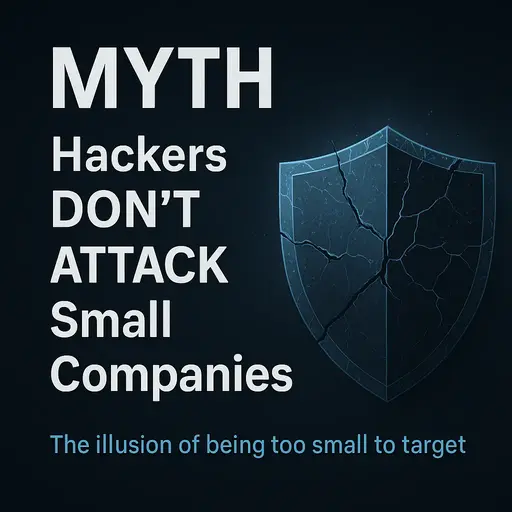
The comforting illusion of being “too small to attack” is costing SMBs more than they realize.
1. The Illusion of Safety
Many small and medium businesses believe cybercriminals only go after the big players — banks, global corporations, and government systems.
That illusion feels safe. It justifies underinvesting in cybersecurity.
But it’s also exactly what attackers rely on.
Hackers know that smaller companies often operate without dedicated security teams, formal monitoring, or mature processes.
To them, this isn’t invisibility — it’s opportunity.
2. The Reality: Attackers Don’t Care About Size
Cybercriminals don’t rank targets by company size.
They look for access, speed, and low resistance.
A small business with a misconfigured cloud instance or weak endpoint protection is often more valuable than a large enterprise with hardened defenses.
Phishing, ransomware, credential theft, and supply-chain compromises hit small businesses every single day — and most never make headlines.
Attackers don’t care how many employees you have.
They care how fast they can break in and cash out.
At Binary10, most cyber forensics requests we receive come from organizations with fewer than 200 employees — clear proof that the idea of being “too small to be noticed” is a dangerous myth.
3. Why SMBs Are the Perfect Targets
Small and mid-sized businesses often check every box on an attacker’s wish list:
- Weaker perimeter and internal defenses
- Outdated or unsupported systems
- Shared admin credentials and poor password hygiene
- Limited or no incident monitoring
- Employees unaware of phishing or social engineering tactics
- Third-party integrations without proper vetting
Individually, these look like minor gaps.
Together, they form a perfect entry path.
4. The Domino Effect — Attacking the Supply Chain
Many small businesses are part of larger ecosystems — vendors, suppliers, technology partners.
Compromising one small vendor can open a door to a far bigger prize.
That’s why cybercriminals often target SMBs first — not for the direct payoff, but to move laterally into their clients’ networks.
In modern supply-chain attacks, the smallest player can trigger the biggest breach.
5. The Cost of Complacency
When breaches happen, it’s rarely just about data.
The fallout includes:
- Operational downtime — systems locked or corrupted
- Financial loss — ransom payments, recovery costs, and penalties
- Reputational damage — lost clients and broken trust
- Regulatory exposure — non-compliance with data protection laws
And the harsh truth?
Most small companies that suffer a major breach never fully recover.
At Binary10, we’ve investigated incidents where a single ransomware infection halted operations for weeks and erased years of customer trust — not because the attack was sophisticated, but because no one believed it could happen to them.
6. Breaking the Myth: What SMBs Can Do
Cybersecurity isn’t about massive budgets — it’s about mindset and discipline.
Every SMB can start with these fundamentals:
- Acknowledge the risk. Stop believing size equals safety.
- Implement basic controls. MFA, backups, patching, access reviews.
- Educate employees. Phishing awareness is your best first defense.
- Vet third parties. Your vendors’ weaknesses become your own.
- Plan for incidents. Detection and response save more than prevention alone.
Security maturity isn’t a luxury; it’s survival.
The Hard Truth
The phrase “We’re too small for hackers” should never be spoken inside your company again.
Attackers don’t discriminate — they automate.
So ask this instead:
Are we too small to be noticed, or just too easy to be breached?
The difference between those two is your next cybersecurity decision.
At Binary10, we help small and mid-sized businesses move from reactive firefighting to proactive cybersecurity maturity — because the size of your company shouldn’t define your exposure, only your preparedness.
FAQs: Cybersecurity Myths and SMB Protection
1. Do hackers target small businesses?
Yes. Attackers don’t filter by company size — they automate. Small and mid-sized businesses frequently appear in scans for weak passwords, exposed services, and unpatched software. Add in valuable data (credentials, invoices, client access) and limited monitoring, and SMBs become reliable, profitable targets. “Small” isn’t invisible; it’s often just unprotected.
2. How do attackers typically compromise small businesses?
Most breaches start with simple entry points: phishing for credentials, reusing leaked passwords, missing MFA, unpatched VPNs/endpoints, misconfigured cloud buckets, exposed RDP, weak vendor portals, and default/admin accounts. Once inside, attackers move laterally, harvest more access, and deploy ransomware or invoice fraud. It’s usually not a “zero-day” — it’s basic hygiene gaps.
3. What are the first controls a small business should implement?
Start with a minimum viable security stack:
- MFA everywhere (email, VPN, admins, finance apps)
- Patch cadence (OS, browsers, VPNs, SaaS integrations)
- Patch cadence (OS, browsers, VPNs, SaaS integrations)
- Email security + phishing training (quarterly)
- EDR/antivirus with alerting, not silent mode
- Access reviews (remove shared/admin accounts; least privilege)
Have an incident response plan and a named external partner before you need one.
Need a quick review of your company’s cybersecurity posture? Schedule a consultation with Binary10
